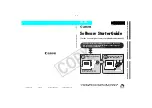
no
vd
ocx (
E
NU)
01
F
ebr
ua
ry
200
6
After completing the basic system setup and the installation of all selected software
packages, the SUSE Linux Enterprise Desktop installation boots into the new Linux system,
after which you can create users, configure the hardware, and set up system services.
If you are installing from CD, leave CD 1 in your CD-ROM drive during the reboot and do not
select any installation options. When the reboot is finished, the installation continued and you
are prompted to insert the remaining CDs.
10
Enter a name for this computer and the DNS domain that it belongs to, then click
Next
.
11
Type a password for the system administrator account (called the
root
user, or
root
), then
click
Next
.
Unlike regular users who might or might not have permission to do certain things on the
system,
root
has unlimited power to do anything, including change the system
configuration, install programs, set up new hardware, and change user passwords. The
root
account should be used only for system administration, maintenance, and repair.
Logging in as
root
for daily work can be risky, because a single mistake could lead to the
irretrievable loss of system files.
You should never forget the
root
password. After you enter it here, the password cannot be
retrieved. It can only be reset with administrative assistance.
12
In the Network Configuration screen, view or change the network connections of your
system, then click
Next
.
If you have network devices (for example, network or wireless cards, a DSL connection,
ISDN adapter, or modem), it is a good idea to configure them now, because an Internet
connection allows SUSE Linux Enterprise Desktop to retrieve any available updates and
include them in the installation.
The network hardware can also be configured after the system installation has been
completed. See the
SUSE Linux Enterprise Desktop 10 GNOME User Guide (http://
www.novell.com/documentation/sled10/userguide_gnome/data/bktitle.html)
and the
SUSE
Linux Enterprise Desktop 10 KDE User Guide (http://www.novell.com/documentation/sled10/
pdfdoc/userguide_kde/userguide_kde.pdf)
for more information.
To skip the network configuration, click
Skip Configuration > Next
.
13
To test your Internet connection, click
Yes, Test Connection to the Internet > Next
.
This option also checks for the latest SUSE Linux Enterprise Desktop release notes. If you
don’t want to test the connection at this point, click
No, Skip This Test > Next
. This also skips
checking for updated release notes.
14
On the Running Internet Connection Test screen, view the results of the test, then click
Next
to continue.
15
On the Novell Customer Center Configuration screen, click
Configure Now > Next >
Continue
to enable your system for online updates.

























